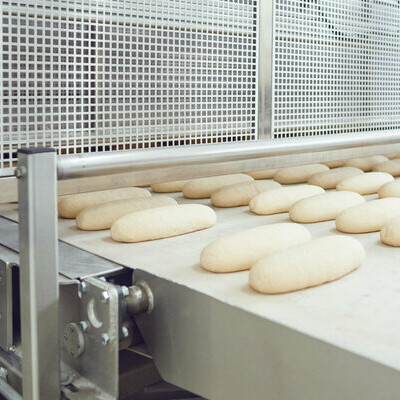
Conveyorized Oven
Also known as continuous oven
What is Conveyorized Oven?
A conveyorized oven is a continuous baking equipment that is designed often as direct gas-fired (DGF)heating units. These ovens are almost exclusively used by high-speed bakeries producing thousands of dough pieces per hour.
- Conveyorized ovens use a transportation system that is based on a robust magnetic grid system with a spiral chain backbone which resembles that of continuous proof boxes.
- Apart from their simplicity of design, the main advantage of a conveyorized oven is the absolute uniformity of bake, since each product takes the same path through the oven chamber which provides consistent baking for even crust color and bakeout.
How it works
A conveyorized oven requires 9 components for its operation:1
- An enclosed and thermally insulated box which functions as the baking chamber to prevent heat leaks and maintain process temperature
- A heating mechanism (DGF) based on combustion of natural gas or propane with the flame propagated and distributed by ribbon burners of given length and thermal output
- A convective and highly turbulent heat transfer system which uses high-temperature fans (centrifugal in most cases) to force the circulation of hot air inside a baking chamber
- A transportation system based on a robust magnetic grid system to convey the pans containing the product inside the baking chamber
- A lubrication system to keep the chain and bearings oiled so that it maintains its mechanical integrity and runs smoothly
- Variable speed exhaust blowers to safely remove products of combustion and prevent water vapor accumulation inside the baking chamber
- Grid / magnet brush cleaner
- Bent-grid detector
- Load on and load off conveyor system
Application
Conveyorized ovens have found extensive use in the production of hamburger buns and rolls. Manufacturing lines dedicated to buns usually have this type of oven installed and, depending on product size and scaling weight, can produce 50,000 to 90,000 buns per hour. Residence times for bun production in the proofer and oven usually are 60 and 12 minutes, respectively.
A conveyorized oven system must be integrated into a conveyorized proof box. The grid pan conveyor carries the panned dough pieces through the final proofer and oven without any transfer breaks or production gaps.
Energy efficiency of conveyorized ovens
Depending on their design, conveyorized ovens may be more energy efficient than DGF tunnel ovens due to the following factors:
- Absence of an energy-consuming cooling-and-reheating cycle for the heavy band system used in tunnel ovens.
- Lower heat leakage through baking chamber insulation thanks to a thicker layer of mineral wool or use of materials with lower thermal conductivity.
- Lower energy consumption in BTU per pound of dough in conveyorized ovens given that these can accommodate more product along the length of the spiral chain which has several turns or loops inside the baking chamber.
Another point to consider with an integrated proofing / baking conveyorized system is the difference in size between the proof box and the oven. This is due to the fact that in the original design the conveyor speed is set to be uniform throughout the production line, requiring a longer proofer conveyor length given its much longer residence time.
References
- Davidson, I. Biscuit Baking Technology. Processing and Engineering Manual, 2nd edition, Academic Press, 2013.

